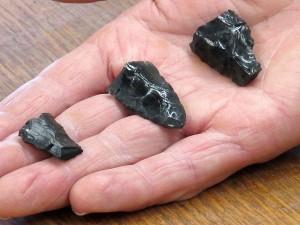THE FIRST AMERICANS, AND THE SECOND AND THIRD AMERICANS TOO. A couple of pieces of news this week about the earliest settlers to arrive in Americas the beautiful. They aren't truly new news, which may be worth pointing out, since they got fairly big play in the MSM,.
I'm not exactly advocating that they not get big play, given that the peopling of the New World is an intrinsically fascinating topic that gets bigger and more complex all the time. But I'd be happier if the reporting about these two papers had pointed out that the findings are confirming ideas that have been extant for a while, which much of it did not.
Although on second thought I suppose the writers would have a hard time selling them to their editors if they couldn't claim that the stories were NEW! NEW! NEW!
So never mind, I take it back.
Bloggers, as usual, had a better grasp of the subtleties. I guess there have continued to be disputes over how many migratory waves came over the Beringia land bridge from Asia, although the idea that there were three major ones — confirmed and refined this week by DNA studies published in Nature — has been approaching conventional wisdom. The new genetic data come from 493 people who belong to 52 groups of Native Americans. At SciAm's Observations, Katherine Harmon explains that not all of the 3 original migrant waves had the same reach, because the second and third groups quickly intermarried with the first.
It's genes from the first group — believed to have arrived here more than 15,000 years ago — that appear to dominate. Those genes are everywhere, from Alaska to Tierra del Fuego. They also predominate among the two more recent migrant groups, the Eskimo-Aleuts and the Chipewyans (who are Na-Dene speakers). Get the basics from Dienekes' Anthropology Blog and see also Greg Mayer at Why Evolution is True.
Dienekes takes note of the genetic evidence for a small amount of back-migration between South and North America (and back again to Central America) and from Alaska back to Asia. He also points out the big gap in the data: none of it is from US Native Americans. That's because the researchers were relying on tissue samples collected for medical reasons and none of the subjects had given consent for population studies, according to Nick Wade's news story in the New York Times. I haven't seen anything suggesting that inclusion of US data could change the picture substantially. But it's undoubtedly a great big hole, and that's always worrisome.
There's a nice animation showing how the Beringia land bridge disappeared here; I wasn't able to embed it, too bad.
Wade's piece also raises one of the more intriguing points of this study: it confirms the hypothesis of 3 major migrations put forth by the linguist Joseph Greenberg a quarter-century ago. Another one of those sad tales of scientific brawling where a researcher posits a theory and his colleagues boo and shout him down — only to be refuted themselves in time. Too bad Greenberg didn't live to see his ideas vindicated.
Not to be outshone by rival Nature, Science also produced a big peopling-of-the-Americas paper this week, this one showing that people were living in Oregon more than 13,000 years ago. That's at least as early, and maybe earlier, as the Clovis people were living in New Mexico, where they were first discovered. Dienekes has the basics on this paper too. At Gene Expression, Razib Khan uses the two papers to mull over the relationship between genetics and culture, both necessary "to produce a better map of reality as it was."
Clovis folks made lovely tools and once were believed to be the First Americans, but that was long ago and far away. One current theory about them is that they originally made their tools in the Southeastern US and then moved west.
Kate Wong has a quite comprehensive post on the Oregon paper at SciAm's Observations. The Oregon finds are significant because they include completely different sorts of tools from Clovis. Also human remains — so far, it appears, the oldest in the Americas, one dated at about 14,500 years ago. The remains are not bones, however. They are fossil feces, which in archaeology are known, decorously, as coprolites. The coprolites contain human mitochondrial DNA similar to mtDNA found in contemporary Native Americans and suggesting an Asian ancestry.
CNN, FOX NEWS, SCOTUSBLOG, THE SUPREME COURT, AND OBAMACARE. Why did CNN and Fox News mess up so badly in reporting the Supreme Court's decision upholding much of the Patient Protection and Affordable Care Act, also known as the ACA and, more universally, as Obamacare? Get the juicy details from Tom Goldstein at SCOTUSblog in a masterfully reported tick-tock recounting events between 10:06 and 10:15 EDT on June 28.
SCOTUSblog was, BTW, denied a press credential for covering the decision. I guess bloggers are still scum. Except to, among others, the White House, which relied largely on SCOTUSblog's conference call and live blog to get the story straight. SCOTUSblog also had to cope with hackers: A denial-of-service attack on its site was launched just as live-blog coverage began. But the site stayed up and the hackers gave up.
The Supreme Court itself was not so fortunate — or so well-prepared. Demand for copies of the decision on the Supreme Court Web site brought it down for half an hour — which meant, Goldstein points out, that for some time citizens (and the White House) were entirely dependent on the the media for information about the decision.
Goldstein reports that CNN's initial error was compounded because the cable network had welded its social media plans for reporting the decision directly to its news coverage — leading to erroneous blogging and tweeting that other (incautious) bloggers and tweeters picked up and perpetuated. Fox News, less enamored of social media (or maybe just less efficient at exploiting it), did not multiply the effects of its error by issuing network tweets and emails, although a couple of its reporters did.
Goldstein concludes by giving SCOTUSblog a pat on the back:
I feel that we showed that a specialized “vertical” — a deep team with focused expertise — can contribute to reporting. We helped the traditional media and the White House, and we distributed the information directly to the public. We also survived hackers, accommodated a record number of visitors, and had a chance to report on one of the most momentous decisions in recent history. And we had a blast doing it.
I think they should get Supreme Court press credentials, don't you?
HUMPTY DUMPTY'S LAW. A word on words. Opponents of the health care law devised the word Obamacare as an epithet, a politicization they may come to regret. Assuming the law survives, my hunch is that eventually Obamacare will become as popular as Medicare. Even now the term is used by nearly everybody else, proponents included, as a simple label rather than a cussword. So the decriminalization of Obamacare is already well along.
"When I use a word," Humpty Dumpty said, in rather a scornful tone, "it means just what I choose it to mean — neither more nor less." "The question is," said Alice, "whether you can make words mean so many different things."



.png)

